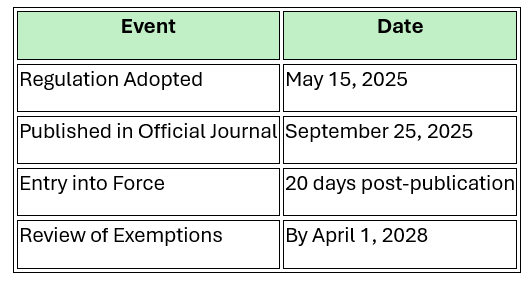The European Commission has updated Regulation (EU) 2019/1021 on persistent organic pollutants (POPs) by adding Dechlorane Plus, a widely used flame retardant, to its list of restricted substances. This amendment brings EU law in line with the Stockholm Convention, which classified Dechlorane Plus as a persistent organic pollutant (POP) in May 2023.
What is Dechlorane Plus?
Dechlorane Plus is a highly persistent and bioaccumulative chemical commonly used in electronics, vehicles, and industrial equipment as a flame retardant. Due to its potential environmental and health risks, it has been designated a substance of very high concern.
Key Dates and Milestones

|
Main Provisions of the Regulation
Inclusion in Annex I:
Dechlorane Plus (including syn- and anti-isomers) is now listed in Annex I of Regulation (EU) 2019/1021, effectively banning its manufacture, use, and sale except under specific exemptions.
Trace Contaminant Limits:
• Until April 15, 2028: Maximum 1,000 mg/kg (0.1% by weight)
• After April 15, 2028: Maximum 1 mg/kg (0.0001% by weight)
Exemptions
Use of Dechlorane Plus remains allowed for:
• Aerospace, space, and defence applications (until February 26, 2030)
• Medical imaging and radiotherapy devices (until February 26, 2030)
• Spare parts and repairs for land-based motor vehicles, agricultural and construction machinery, marine and outdoor equipment
• Instruments for analysis and monitoring
• Medical and in vitro diagnostic devices (until end of service life)
Review Mechanism
The European Commission will reassess the need to extend exemptions by April 1, 2028, ahead of the 2029 Stockholm Convention meeting.
Why This Matters
This amendment reinforces the EU’s commitment to chemical safety and environmental protection by controlling a hazardous flame retardant. It aligns with international obligations and provides clarity to industries dependent on Dechlorane Plus for critical applications.
Next Steps for Stakeholders
• Manufacturers and Importers: Review product formulations and supply chains to comply with new restrictions.
• Regulatory Teams: Prepare for enforcement of trace contaminant limits and track exemption deadlines.
• Member States: Implement enforcement and compliance monitoring following the regulation’s entry into force.
Reach out to our regulation experts on chemical and product regulatory compliances



